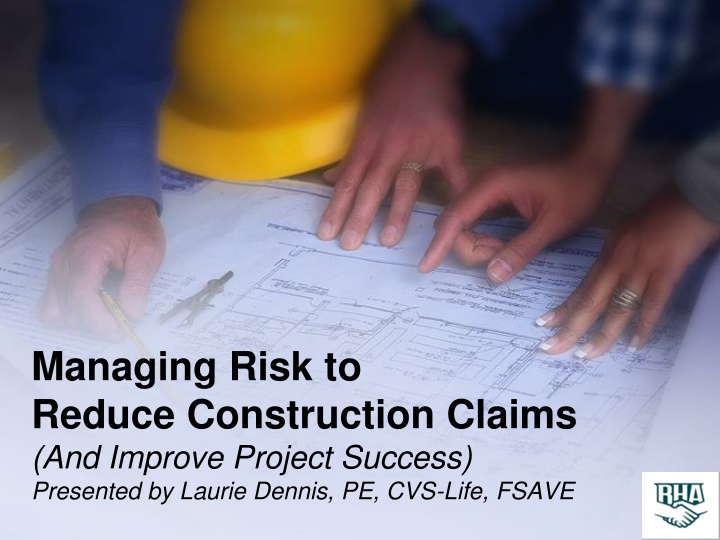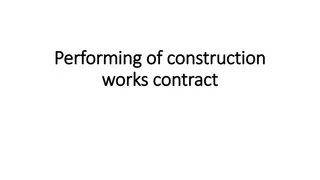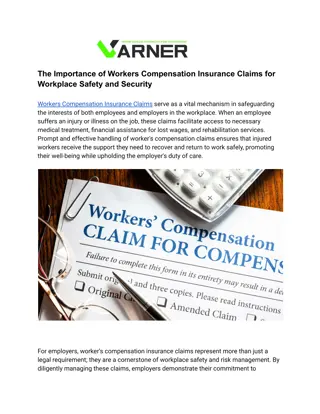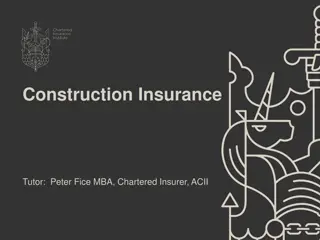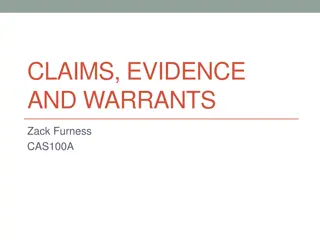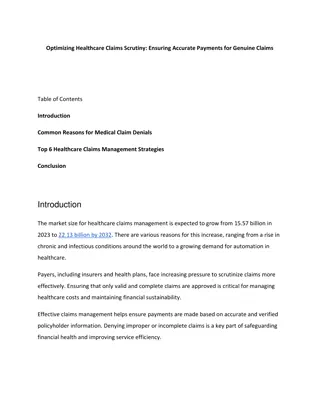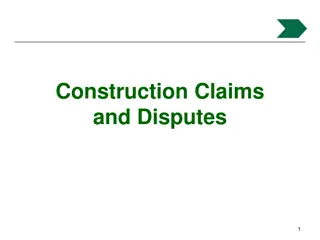Managing Project Risk to Reduce Construction Claims
Construction projects face risks such as escalating costs, incomplete plans, and design issues. Managing project risk is crucial to avoid adverse impacts and maximize opportunities for successful project outcomes. This presentation by Laurie Dennis covers the definition of project risk, importance of risk management, risk assessment process, risk identification, treatment, and integration into organizational processes.
Uploaded on Sep 20, 2024 | 1 Views
Download Presentation

Please find below an Image/Link to download the presentation.
The content on the website is provided AS IS for your information and personal use only. It may not be sold, licensed, or shared on other websites without obtaining consent from the author.If you encounter any issues during the download, it is possible that the publisher has removed the file from their server.
You are allowed to download the files provided on this website for personal or commercial use, subject to the condition that they are used lawfully. All files are the property of their respective owners.
The content on the website is provided AS IS for your information and personal use only. It may not be sold, licensed, or shared on other websites without obtaining consent from the author.
E N D
Presentation Transcript
Managing Risk to Reduce Construction Claims (And Improve Project Success) Presented by Laurie Dennis, PE, CVS-Life, FSAVE
Presentation Objectives What is the definition of project risk Why managing risk is important When to use risk assessments An overview of the risk assessment process How to identify and assess risk Treating the risk Managing the risk assessment process Integrating risk into your organization
What Is The Cause? Escalating construction costs due to: Incomplete plans Design issues not mitigated and pushed into construction Constrained design schedules; issues not resolved Very little discussion of risk and impacts Not understanding the true impacts related to the risk
What is a Risk An uncertain event or condition that, if it occurs, has a positive or negative effect on at least one project objective. A risk may have one or more causes and, if it occurs, one or more impacts.
Threats vs Opportunities A negative risk is described as a Threat causing an adverse impact on a project goal. A positive risk is described as an Opportunity causing a positive impact on a project goal.
What is a Risk Risk can typically be divided into the following three categories; Political this can be defined as communities, permitting, management priorities, users, approvals, media, and internal stakeholders/ project team issues. Technical this is the most common for design and construction projects and is typically represented by requirements, regulatory, technology, data, design, construction, maintenance, operations, life cycle asset management, and cost. (i.e., health, safety, environmental, etc.)
What is a Risk Contractual this is most commonly related to funding, negotiations, scope of work, qualification requirements, certification requirements, incentives, penalties and defaults.
Importance of Managing Project Risk Avoid and/or minimize adverse impacts Planning Design Construction Commissioning Maximize opportunities to improve project objectives Avoid and/or minimize management by crisis Better decision-making; understanding all impacts Help keep management apprised of project issues
Risk and Project Management All phases will benefit from the analysis Planning Programmatic decision-making Formulates initial approaches to determine level of effort and potential cost implications Project Initiation Developing project scope/complexity Budgetary impacts Project Feasibility/Pre-Design Reducing potential risks during concept development Alternative selection
Risk and Project Management Design Managing project risks Minimizes construction impacts (cost & schedule) Construction and Commissioning During the Partnering session Informs construction of risks identified through the design process Provides new information from a contractors perspective helps to reduce or eliminate risks impacting the schedule, budget and delivery Identifies potential impacts to avoid commissioning problems and challenges
Risk and Project Management Alternative Delivery GCCM/CMAR Used by the GCCM/CMAR team to develop an understanding and provide ideas for risk mitigation in their proposals Formalized workshop with all parties Design/Build Used by the owner developing and finalizing the RFP documents Used by the D/B team to develop an understanding and provide ideas for risk mitigation in their proposals
What is a Risk Assessment It is a focused effort to discover and act on risks and opportunities that can affect a project s scope, schedule, budget or quality early in the project and continuously throughout the project life cycle. It is a quantitative and qualitative approach to identifying risk, which includes both the negative sides of risk and opportunities, and evaluates the likelihood and potential impact.
Risk Approaches Quantitative electronically modeling the project schedule and/or cost estimate. Uses a Monte Carlo-type simulation. Qualitative using a simplified tool, such as a risk register to identify and then track, using an order of magnitude impact to cost and schedule.
Risk Assessment Process Planning for the Workshop Initial Risk Assessment Workshop Stand-alone Jointly with a value engineering study Risk Register Updates Follow-up Workshops Risk Database Updates Transfer Risk Information to Construction Combine with a Partnering workshop Part of the project start-up
Risk Assessment Process With Value Engineering Study Identify Risks Evaluate Risks Using Risk Register Creative Mitigation or Elimination Risk Develop Ideas Define Potential Impacts
Risk Assessment Process Project Close-out Update the risk database (knowledge transfer)
Risk Planning Information and Data Gathering Stakeholder Identification and Involvement Risk Assessment Team Determine Level of Project Complexity High complexity/consequences High importance Review Existing Data Including the Risk Database Workshop Logistics Workshops/Meetings
Risk Identification and Analysis 3/1/2012 DATE: Project Name Highly Likely > 70% Catastrophic SubstantialModerate 100 Extremely High Red (50- 100) Likely 51 - 70% Possible 21 - 50% Unlikely 5 - 20% Marginal 5 High Orange (15 - 49) Very unlikely < 5% Negligible 1 Probability of Occurrence MATRIX KEY Severity of Impact 50 20 Moderate Low Risk Rating Yellow (3 - 14) Green (0 - 2.9) Identify the Risk Description of Risk Assign the Risk Who does the risk affect? Classify the Risk Quantify Risk Response Risk ID Probability of Occurance % Severity of Impact (numeric) Risk Rating $$ Schedule Impact Avoid? Mitigate? Accept? Transfer? Comments Impact 1 Risk Category Slpoping Construction 1.1 60% 50 100.0 1.2 0.0 1.3 0.0 1.4 0.0 1.5 0.0 1.6 0.0 1.7 0.0 1.8 0.0 1.9 0.0
Status of Risk Threats Avoid/Eliminate Clarifying requirements, obtain information, improve communication, acquire expertise. Transfer/Share Gives the risk to a third party, does not eliminate the potential costs or exposure. Where is the best place for the risk to borne. Mitigate/Reduce the Likelihood Accept There are many risks that will occur regardless of mitigation measures, these are accepted and then accounted for in the scope, schedule and budget.
Status of Risk Opportunities Accept Ensure that the opportunity is realized. Might include escalating a schedule for early completion. Share Apportioning ownership between two or more. Might include using performance specifications. Enhance Increasing the probability that it will occur. Might include facilitating the cause to increase the probability.
Managing the Plan Manage and update the risk register and treatment plan Track assignments for completion Monitor the watch list Decision-making and keeping management informed
Integrating Risk Assessments Establish a formal process and integrate into your project management plan Establish a risk data-base Identify a risk coordinator for each project (May be the Project Manager) Establish management support and buy in Track statistics and share the data to support the process and the successes
Presenter Laurie Dennis, PE, CVS-Life, FSAVE RHA, LLC (206) 200-9798 email: lmdennis@earthlink.net
